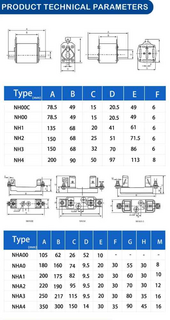I think the NHA is referring to the fuse holder dimensions and not the fuse....not sure though,,,, but I believe all the bottom dimensions are fuse holder size dimensions????
Old thread but I'll throw in my 0.05$.
The FIRST thing you need to determine is which fuse tripping characteristic you are going to use:
- aR: semiconductor fuse, ultra fast, short-circuit protection ONLY (NO overload protection !), HIGH power dissipation
- gS: semiconductor fuse, very fast, short-circuit protection and overload protection, medium power dissipation
- gBat: semiconductor fuse, quite-very fast, short-circuit protection and overload protection, medium power dissipation
- gR: semiconductor fuse, relatively fast, short-circuit protection and overload protection, medium power dissipation
- gG: general purpose fuse, slow, short-circuit protection and overload protection, low power dissipation
Check:
- Prospective Short-Circuit current vs Clearing Time Curve
- Peak Limiting / Let-through Current Curve
- Pre-Arcing I2t value (take it with a pinch of salt - the value is typically given for AC circuits under some controlled conditions)
- Arcing I2t value (take it with a pinch of salt - the value is typically given for AC circuits under some controlled conditions)
THEN:
-
Check the power dissipation of your fuse at the operating current (including unbalance: 20-30% unbalance is typical) and check that the fuse holder can withstand it
- For aR fuses you need to MASSIVELY oversize the fuse with respect to your operating current, simply because the power dissipation is HUGE
- For aR fuse a Breaker (or other fuse) OVERLOAD protection is required.
What I did for operating current of 100 ADC:
- Fuse aR 315A NH1 (1 for DC+, 1 for DC-)
- Breaker type Schneider Electric C120H-B100 (2P)
You won't protect much if you are planning on installing a gG fuse ...
At the very least go for gR.
I would NOT go below gS / gBat. aR is preferred but make sure you have overload protection though some other means !
In the future I might change for operating current of 100 ADC:
- Fuse aR 200A-250A NH00 (1 for DC+, 1 for DC-) and/or Fuse gBat 125A NH00 (1 for DC+, 1 for DC-)
- Breaker type Schneider Electric C120H-B100 (2P)
For the same Fuse Tripping Characteristic and Nominal Current, a NH00 fuse will have a lot LESS power dissipation than a NH1. Similarly NH1 will have LESS power dissipation than NH2. And so on.
EDIT 1: When paralleling fuses, besides the current unbalance issue, you also need to be aware that the I2t value of the "equivalent fuse" (the I2t delivered to the load/inverter/charger/etc in case of a fault) is the SUM of the I2t of each fuses.
So for instance 3 x 100A fuse will give you 300A operating current (ideally, WITHOUT considering unbalance / current sharing), but 3 x (I(t)
)^2 where I(t) is extracted from the fuse Prospective Current vs Clearing Time Characteristic.




